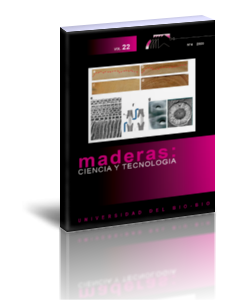Effect of expanded polystyrene content and press temperature on the properties of low-density wood particleboard
Keywords:
Density profile, expanded polystyrene (EPS), low-density particleboard, mechanical properties, microstructure, press temperatureAbstract
In this study, three-layer low-density (about 400 kg/m3) particleboards consisting of a mixture of wood particles and expanded polystyrene (EPS) were manufactured. EPS bead was incorporated in the core layer as a light filler. The influence of EPS content (0 %, 2,5 %, 5 %, 7,5 %, 10 % and 12,5 %) and press temperature (110 °C and 140 °C) on the microstructure, density profile, bending properties, internal bond and thickness swelling of the panels was investigated. Results showed that incorporation of EPS beads filled in the voids between wood particles, improved the core layer integrity, and generated a more pronounced density profile. Consequently, the bending properties and internal bond of panels adding EPS were remarkably improved, and the thickness swelling was decreased. However, the variation of the amount of EPS from 2,5 % to 12,5 % had no significant effect on the bending properties and thickness swelling. Comparing the two press temperatures, although higher temperature (140 °C) was more favourable in control panels without EPS as filler, it had a negative effect on the properties of panels with addition of EPS filler, especially for high EPS contents (10 % and 12,5 %), attributing to the shrinkage of EPS bead under press temperature that is much higher than its glass transition temperature (104 °C).
Downloads
References
Barbu, M.C. 2016. Evolution of lightweight wood composites. Pro Ligno 11(4): 21-26.
Benthien, J.T.; Ohlmeyer, M. 2016. Influence of face-to-core layer ratio and core layer resin content on the properties of density-decreased particleboards. Eur J Wood Wood Prod 75(1): 55-62. http://doi.org/10.1007/s00107-016-1059-5.
Dziurka, D.; Mirski, R.; Dukarska, D.; Derkowski, A. 2015. Possibility of using the expanded polystyrene and rape straw to the manufacture of lightweight particleboards. Maderas-Cienc Tecnol 17(3): 647-656. http://dx.doi.org/10.4067/S0718-221X2015005000057.
Fernando, P.L.N.; Jayasinghe, M.T.R.; Jayasinghe, C. 2017. Structural feasibility of Expanded Polystyrene (EPS) based lightweight concrete sandwich wall panels. Constr Build Mater 139: 45-51. https://doi.org/10.1016/j.conbuildmat.2017.02.027.
Jafarnezhad, S.; Shalbafan, A.; Luedtke, J. 2018. Effect of surface layers compressibility and face-to-core-layer ratio on the properties of lightweight hybrid panels. Int Wood Prod J 9(4): 164-170. https://doi.org/10.1080/20426445.2018.1546979.
Lyutyy, P.; Bekhta, P.; Ortynska, G. 2018. Lightweight Flat Pressed Wood Plastic Composites: Possibility of Manufacture and Properties. Drvna Ind 69(1): 55-62. https://hrcak.srce.hr/196968.
Mir, S.; Farrokhpayam, S.R.; Nazerian, M.; Mansouri, H.R. 2016. Lightweight particle board using expanded polystyrene. Journal of Wood and Forest Science and Technology 22(4): 239-254. https://www.sid.ir/en/Journal/ViewPaper.aspx?ID=526618.
Monteiro, S.; Martins, J.; Magalhães, F.; Carvalho, L. 2016. Low Density Wood-Based Particleboards Bonded with Foamable Sour Cassava Starch: Preliminary Studies. Polymers 8(10): 354. https://doi.org/10.3390/polym8100354.
Monteiro, S.; Martins, J.; Magalhães, F.D.; Carvalho, L. 2018. Lightweight Wood Composites: Challenges, Production and Performance. In: Lignocellulosic Composite Materials, 1st ed. Kalia, S. (Ed.). Springer International Publishing. Cham, Switzerland. pp. 293-322. https://doi.org/10.1007/978-3-319-68696-7_7.
Monteiro, S.; Martins, J.; Magalhaes, F.D.; Carvalho, L. 2019. Low Density Wood Particleboards Bonded with Starch Foam-Study of Production Process Conditions. Materials (Basel) 12(12): 1975. https://doi.org/10.3390/ma12121975.
Shalbafan, A.; Tackmann, O.; Welling, J. 2015. Using of expandable fillers to produce low density particleboard. Eur J Wood Wood Prod 74(1): 15-22. https://doi.org/10.1007/s00107-015-0963-4.
Shalbafan, A.; Welling, J.; Luedtke, J. 2012. Effect of processing parameters on mechanical properties of lightweight foam core sandwich panels. Wood Mater Sci Eng 7(2): 69-75. https://doi.org/10.1080/17480272.2012.661459.
Sundquist, D.J.; Bajwa, D.S. 2016. Dried distillers grains with solubles as a multifunctional filler in low density wood particleboards. Ind Crops Prod 89: 21-28. https://doi.org/10.1016/j.indcrop.2016.04.071.
Thoemen, H.; Irle, M.; Sernek, M., 2010. Wood-Based Panels: an Introduction for Specialists, 1st ed. Brunel University Press, London, UK.

































